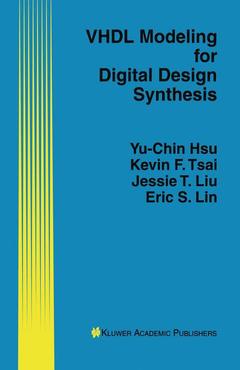Description
VHDL Modeling for Digital Design Synthesis, Softcover reprint of the original 1st ed. 1995
Authors: Yu-Chin Hsu , Tsai Kevin F., Liu Jessie T., Lin Eric S.
Language: English
Subjects for VHDL Modeling for Digital Design Synthesis:
Keywords
Hardware; Standard; VHDL; algorithms; design process; digital design; modeling; simulation
210.99 €
In Print (Delivery period: 15 days).
Add to cart
Publication date: 10-2012
356 p. · 15.5x23.5 cm · Paperback
356 p. · 15.5x23.5 cm · Paperback
Description
/li>Contents
/li>Comment
/li>
The purpose of this book is to introduce VHSIC Hardware Description Lan guage (VHDL) and its use for synthesis. VHDL is a hardware description language which provides a means of specifying a digital system over different levels of abstraction. It supports behavior specification during the early stages of a design process and structural specification during the later implementation stages. VHDL was originally introduced as a hardware description language that per mitted the simulation of digital designs. It is now increasingly used for design specifications that are given as the input to synthesis tools which translate the specifications into netlists from which the physical systems can be built. One problem with this use of VHDL is that not all of its constructs are useful in synthesis. The specification of delay in signal assignments does not have a clear meaning in synthesis, where delays have already been determined by the im plementationtechnolo~y. VHDL has data-structures such as files and pointers, useful for simulation purposes but not for actual synthesis. As a result synthe sis tools accept only subsets of VHDL. This book tries to cover the synthesis aspect of VHDL, while keeping the simulation-specifics to a minimum. This book is suitable for working professionals as well as for graduate or under graduate study. Readers can view this book as a way to get acquainted with VHDL and how it can be used in modeling of digital designs.
1 Introduction.- 1.1 Design Process.- 1.2 Levels of Abstraction.- 1.3 Design Tools.- 1.4 VHSIC Hardware Description Languages.- 1.5 Simulation.- 1.6 Synthesis.- 1.7 Summary.- 2 Basic Structures in VHDL.- 2.1 Entity Declarations.- 2.2 Architectures.- 2.3 Packages.- 2.4 Configurations.- 2.5 Design Libraries.- 2.6 Summary.- 3 Types, Operators and Expressions.- 3.1 Data Objects.- 3.2 Data Types.- 3.3 Operators.- 3.4 Operands.- 3.5 Summary.- 4 Sequential Statements.- 4.1 Variable Assignment Statements.- 4.2 Signal Assignment Statements.- 4.3 If Statements.- 4.4 Case Statements.- 4.5 Null Statements.- 4.6 Assertion Statements.- 4.7 Loop Statements.- 4.8 Next Statements.- 4.9 Exit Statements.- 4.10 Wait Statements.- 4.11 Procedure Calls.- 4.12 Return Statements.- 4.13 Summary.- 5 Concurrent Statements.- 5.1 Process Statements.- 5.2 Concurrent Signal Assignments.- 5.3 Conditional Signal Assignments.- 5.4 Selected Signal Assignments.- 5.5 Block Statements.- 5.6 Concurrent Procedure Calls.- 5.7 Concurrent Assertion Statements.- 5.8 Summary.- 6 Subprograms and Packages.- 6.1 Subprograms.- 6.2 Packages.- 6.3 Summary.- 7 Modeling at the Structural Level.- 7.1 Component Declarations.- 7.2 Component Instantiations.- 7.3 Generate Statements.- 7.4 Default Bindings.- 7.5 Configuration Specifications.- 7.6 Configuration Declarations.- 7.7 Modeling a Test Bench.- 7.8 Summary.- 8 Modeling at the RT Level.- 8.1 Combinational Logic.- 8.2 Latches.- 8.3 Designs with Two Phase Clocks.- 8.4 Flip-Flops.- 8.5 Synchronous Sets And Resets.- 8.6 Asynchronous Sets And Resets.- 8.7 VHDL Templates for RTL circuits.- 8.8 Registers.- 8.9 Asynchronous Counters.- 8.10 Synchronous Counters.- 8.11 Tri-State Buffers.- 8.12 Busses.- 8.13 Netlist of RTL Components.- 8.14 Summary.- 9 Modeling at the FSMD Level.- 9.1 Moore Machines.- 9.2 Asynchronous Mealy Machines.- 9.3 Synchronous Mealy Machines.- 9.4 Separation of FSM and Datapath.- 9.5 An FSM with a Datapath (FSMD).- 9.6 Communicating FSMs.- 9.7 Summary.- 10 Modeling at the Algorithmic Level.- 10.1 Process and Architecture.- 10.2 Wait Statements.- 10.3 Synchronous Reset.- 10.4 Asynchronous Reset.- 10.5 Registers and Counters.- 10.6 Simple Sequential Circuits.- 10.7 Algorithms.- 10.8 Process Communication.- 10.9 Summary.- 11 Memories.- 11.1 Memory Read/Write at the RT Level.- 11.2 Memory Inference at the Algorithmic Level.- 11.3 Summary.- 12 VHDL Synthesis.- 12.1 VHDL Design Descriptions.- 12.2 Constraints.- 12.3 Technology Library.- 12.4 Delay Calculation.- 12.5 The Synthesis Tool.- 12.6 Design Space Exploration.- 12.7 Synthesis Directives.- 12.8 Summary.- 13 Writing Efficient VHDL Descriptions.- 13.1 Software to Hardware Mapping.- 13.2 Variables and Signals.- 13.3 Using minimum bit width.- 13.4 Using effective algorithms.- 13.5 Sharing complex operators using module functions.- 13.6 Specifying don’t care conditions.- 13.7 Writing low level code.- 13.8 Summary.- 14 Practicing Designs.- 14.1 Bit Clock Generator.- 14.2 Traffic Light Controller.- 14.3 Vending Machine.- 14.4 Black Jack Dealer Machine.- 14.5 Designing a Stack Computer.- References.
Introduction. Basic structures in VHDL. Types, operators and expressions. Sequential statements. Concurrent statements. Subprograms and packages. Modelling at the structural level. Modelling at the RT level. Modelling at the FSMD level. Modelling at the algorithmic level. Memories. VHDL synthesis. Writing efficient VHDL descriptions. Practicing designs.
© 2024 LAVOISIER S.A.S.
These books may interest you

Circuit Synthesis with VHDL 158.24 €



